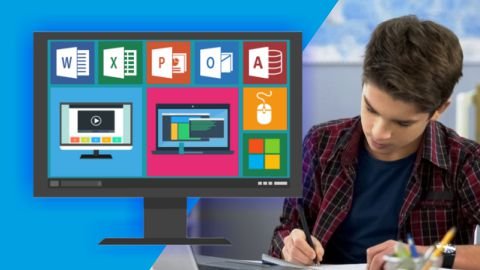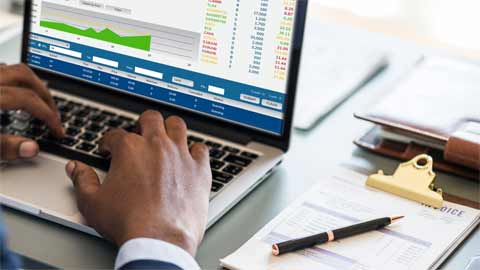What you'll get
- Job Credibility
- Certification Valid for Life
- On-demand video*
- E-Book
- Self-Paced Learning
- Certificate of Completion
Exam details
- Mode of Exam : Online
- Duration : 1 Hour
- Multiple Choice Questions are asked
- No. of Questions are asked : 50
- Passing Marks : 25 (50%)
- There is no negative marking
The full form of MDCA is Master Diploma in Computer Application. It is an online course that teaches you advanced technology in computer courses with an easy guide. it is a Long term course which Includes easy and advanced tutorials on computer applications. However, It's all up to you whether you finish this course in a long term period or a short term period. Because, The course is completely online, So you have the option to finish it fast.
Additionally, You learn about computers through online sessions, where you have the option to practice each topic thoroughly. and therefore, it creates an advanced learning environment for you. and through it, You can retain more computer Knowledge and its application in your mind for a long time. which you cannot get from theoretical classes. However, If you wish to study theory, we do have some lectures in PDFs format. that you can easily download from your account. That's why this course is best for you because we want you to be educated in the field of computer education. Therefore, we have categorized the course into 6 Modules which you can see in the course "content section" above.
What you are going to learn in this course?
- Fundamental of Computer
- Microsoft Office
- Basics of Internet Technology
- Editing and Profiling Tools
- Basics of HTML Programming
- Interactive Tools like ASP, JAVA, VB Script etc.
- IT Tools and Operating System
- Adobe Photoshop
- CorelDRAW
- Adobe PageMaker
- Fundamentals of Financial accounting
- Accounting and Tally ERP
Are you worried about your bright career? Well, You don't need to worry about it. You are going to have proper skills in the digital field which makes you high in demand across the world. Surprisingly, It's going to help you to grab a job in the marketplace. Wherever It's needed you can apply it for a job.
Certifications
You proudly get a certificate after completion of the course, you can download it as soon as you complete your course exam. Then, later on, You can request your certificate hard copy, as you do, we are ready to deliver it to your registered address.
So, Don’t wait, just contact us right away and we shall help you to buy a course.
Course Content
-
1 What is computer system
-
2 Basic Applications of Computer System
-
3 Components of Computer System
-
4 Other Input_Output devices
-
5 Memory Location
-
6 Concepts of Hardware and Software
-
7 Data and Information
-
8 Connectiog Keyboard Mouse, Monitor and Printer to CPU and Checking Power Supply
-
Operating System Installation
-
4.21 Introduction To Word Processing
-
4.22 Opening a Word Processing Package
-
4.23 Opening an existing document
-
4.24 Saving a document
-
4.25 Closing a document
-
4.26 Text selection
-
4.27 Editing Text
-
4.28 Find and Replace
-
4.29 Printing a Document
-
4.210 Creating and Printing Merged documents
-
4.211 Character Formatting
-
4.212 Paragraph Formatting
-
4.213 Page Design and Layout
-
4.31 Checking and Correct spelling
-
4.32 Handling Graphics
-
4.33 Creating tables and charts
-
4.34 Document Templates and Wizard
-
5.21 Overview of Spreadsheet
-
5.31 Working with spreadsheet
-
5.32 Inserting and Deleting a worksheet
-
5.33 Entering data into spreadsheet
-
5.41 Handling Operators
-
5.51 Functions
-
5.61 Formatting a worksheet
-
5.71 Printing a worksheet
-
5.81 Working with charts
-
5.91 Integrating text into spreadsheet
-
5.92 Integrating text web pages into spreadsheet
-
6.21 Overview of PowerPoint
-
6.22 Creating a Presentation
-
6.23 Saving a Presentation
-
6.31 Views in Presentation
-
6.32 Working with slides
-
6.33 Adding and Formatting Text
-
6.34 Formatting Paragraphs
-
6.35 Checking spelling and correcting typing mistakes
-
6.36 Making Notes Master and Handouts
-
6.37 Drawing Objects
-
6.38 Working with objects
-
6.39 Insert Clip Art and Pictures
-
6.310 Designing slide show
-
6.311 Printing Slides
-
Internet
-
ARPANET and Internet history of the World Wide Web
-
Owners of the Internet
-
Anatomy of Internet
-
Growth of Internet
-
Basic Internet Terminology
-
Net
-
Commerce on the Internet
-
Governance on the Internet
-
Impact of Internet on Society
-
Crime on through the Internet
-
Checking and correct spelling
-
Handling graphics
-
Creating tables and Charts
-
Document Templates and wizard
-
Current Trends on Internet
-
Languages
-
Internet Phone
-
Internet Video
-
Collaborative Computing
-
E-Commerce
-
Email Networks and Servers
-
SMTP (Simple Mail Transfer Protocol)
-
Post Office Protocol (POP3)
-
Internet Message Access Protocol 4 (IMAP4)
-
Multi-propose Internet Mail Extension (MIME)
-
Email address
-
Email Header
-
Message Body and Attachments
-
Email Clients
-
Netscape Mail Clients
-
Outlook express
-
Web based Email
-
Email Encryption
-
Address book
-
Signature File
-
Introduction to HTML
-
HTML Editors
-
Overview of HTML Markup
-
Basic HTML Tags
-
A Head Tags
-
B Paragraph Tags
-
C Line Break Tags
-
D Centering Content
-
E Preserver Formatting
-
HTML Attributes
-
HTML Text
-
HTML Links
-
HTML Document Tables
-
HTML Frames
-
A Frames Tag Attribute
-
B Creating Frames
-
Forms
-
A Forms Attributes
-
HTML Images
-
Multimedia
-
Active Server Pages (ASP)
-
Interactive Tools
-
VB Script
-
A VB Script Variables and Constants
-
Java and Front Page
-
Java Script
-
Flash
-
B Tools in Flash Player
-
C Grouping
-
D Layering
-
Internet Connectivity
-
Level Two Connectivity
-
Level Three Connectivity
-
Hardware Requirement
-
Selection of a Modem
-
Software Requirement
-
Modem Configuration
-
Network Definition
-
LAN
-
LAN Applications
-
WAN
-
WAN Connection Types
-
Node
-
Host
-
Workstation
-
Bandwidth
-
Interoperability
-
Network Administrator
-
Network Security
-
How to install operating system?
-
What is Photoshop CC? Complete Introduction
-
How to use Workspace in PhotoShop CC
-
Photoshop LAYERS Tutorial
-
Photoshop Layer Mask Tutorial with Example
-
How to use Photoshop Layer Styles & Effects [Example]
-
How to Draw Shapes in Photoshop using Shape Tool
-
What is Smart Object? How to use Smart Object in Photoshop?
-
Blending Modes in Photoshop
-
How to use Pen Tool in Photoshop? Complete Tutorial
-
How to Remove Background in Photoshop?
-
How to use Brush Tool in PhotoShop?
-
How to use Photoshop Text Tool to add Text
-
How to use Filters & Effects in Photoshop
-
Whats New in CorelDRAW X7
-
A look at the application interface
-
Understanding the CorelDRAW X7 Welcome Screen
-
How to Create a Brochure Template
-
How to Customize the CorelDRAW Workspace
-
How to Use Color Harmonies
-
How to Use Print Merge
-
10 Tips for Better CorelDraw Productivity
-
Working with Transparencies
-
CorelDRAW Video Tip: Open and Import .CDR Files
-
CorelDRAW Video Tip: Basic Transformations
-
CorelDRAW Video Tip: Drawing Basic Shapes
-
How to Weld, Trim and Combine Objects
-
Working with Layers in the Object Manager
-
How to Use the Transparency Tool
-
Advanced Transparency Effects
-
Clipping Objects into Other Objects with PowerClip
-
Create a Chiseled Effect
-
Create a Mosaic Text Effect
-
Using PowerClip
-
Creating a Distressed Look
-
Introduction to the Course
-
What is Accounting
-
3 Sets of Books
-
An Informational Role for Financial Accounting
-
Accounting Standards inside the US
-
Accounting Standards Outside the US
-
Assets
-
financial statements
-
Liabilities
-
Owner's equity
-
The accounting cycle
-
The balance sheet
-
The framework
-
The summary of the Balance sheet
-
TGS Year 1 Transaction 5 and a Summary
-
TGS Year 1 Transaction 4
-
TGS Year 1 Transaction 3
-
TGS Year 1 Transaction 2
-
TGS Year 1 Transaction 1
-
T-Accounts A Tutorial
-
Recording Transactions Your Turn
-
Recording Transactions Example 3
-
Recording Transactions Example 2
-
Recording Transactions Example 1
-
Journal Entries A Tutorial
-
The income Statement A Summary
-
Revenues
-
Introduction to Income Statement
-
Expenses
-
TGS Year 1 Transaction 8
-
TGS Year 1 Transaction 7
-
TGS Year 1 Transaction 6
-
Revenue and Expense Transactions A Tutorial
-
Recording Revenue and Expense Transactions Your Turn
-
TGS Year 1 Transaction 11 and a Summary
-
TGS Year 1 Transaction 9
-
TGS Year 1 Transaction 10
-
Recording Adjusting Entries Your Turn
-
Adjusting Entries A Tutorial
-
Closing Entries
-
Introduction to Financial Statement Preparation
-
TGS Year 1 Preparing the Balance Sheet
-
TGS Year 1 Preparing the Income Statement
-
TGS Year 1 Revisiting the Financial Statement Framework
-
Explaining the Change in Cash A Tutorial
-
Introduction to the Statement of Cash Flows
-
TGS Year 1 Preparing the Financing Activities Section of the Statement of Cash Flows
-
TGS Year 1 Preparing the Investing Activities Section of the Statement of Cash Flows
-
TGS Year 1 Preparing the Operating Activities Section of the Statement of Cash Flows
-
TGS Year 1 Using the Direct Method to Prepare the Statement of Cash Flows
-
TGS Year 1 Using the Indirect Method to Prepare the Statement of Cash Flows
-
The Direct and Indirect Methods A Summary
-
The Statement of Cash Flows A Conceptual Understanding
-
A Managerial Approach to Recording Transactions
-
Transactions from the Viewpoint of a Manager
-
PepsiCo's 10-K
-
PepsiCo's Annual Report
-
Analysis of the Balance Sheet and a Summary
-
Analysis of the Income Statement
-
Analysis of the Statement of Cash Flows
-
Introduction to TGS Year 2
-
TGS Year 2 Transactions 1-7
-
TGS Year 2 Transactions 8-11
-
TGS Year 2 Transactions 12-16
-
TGS Year 2 Transactions 17-22
-
TGS Year 2 The Financial Statements
-
TGS Year 2 Preparing the Financing Activities Section of the Statement of Cash Flows
-
TGS Year 2 Preparing the Investing Activities Section of the Statement of Cash Flows
-
TGS Year 2 Preparing the Operating Activities Section of the Statement of Cash Flows
-
TGS Year 2 Revisiting the Financial Statement Framework
-
A STUDENT PERSPECTIVE ON LEARNING PROGRAMMING
-
COURSE OVERVIEW
-
Resources to Help You Succeed
-
Tips for Learning Programming
-
A Seven Step Approach to Solving Programming Problems
-
Developing an Algorithm
-
Everything Is a Number
-
How Is That a Number
-
Introduction
-
Buttons with Divs
-
Changing Pages Interactively
-
Inputs and Events
-
Event Driven Programming
-
Using HTML5 Canvas
-
Image filter on the Web
-
How to download, install and activate Tally.ERP 9
-
How to create company in Tally.ERP 9
-
How to create ledgers in Tally.ERP 9
-
How to create stock items and groups in Tally.ERP 9
-
How to set GST details in Tally.ERP 9
-
How to record purchases and sales in Tally.ERP 9
-
How to record payments and receipts in Tally.ERP 9
-
Tally Shortcuts
-
Concepts of Accounting
-
Daily Voucher Entry in Tally
-
Financial Reports
-
Printing
-
Inventory Control
-
Advantages of Adobe Pagemaker
| Duration |
| 1.5 Year |
| Certification |
| Diploma |
Reviews
Related Courses
1- Select your Course for Certification.
2- Click on Buy Now.
3- Proceed to Checkout If You are registered User or Create an Account.
4- Choose Your Billing Address or Add New and Click on Continue.
5- Choose Payment Method and Click on Continue to Complete Your Payment.
6- After Successful Payment You will receive an Email regarding your order, and You can login your account in order to access the course and its exam.
7- After, You Finish an exam, and qualified it, you will be able to download your certificate immediately.
To buy a course, you need to click on the ‘Buy Now’ option available on the course page. After clicking on it, you can proceed ahead and make the payment of the course using a convenient mode of payment to buy it. For Help Watch a video here
After you have selected the course
that you wish to purchase, click on the ‘Buy Now’ option on the course page.
This will redirect you to the Checkout page. In case you wish to apply any
coupon code, the page will provide you an option to do so.
If you are new to the site, you will
be asked first to create an account, In this case, you will have to fill a form.
On the Checkout page, simply select
the payment mode that you wish to use for purchasing the course. The payment
options available are Credit/ Debit Card, Internet Banking, as well as UPI.
After making the payment successfully, you will receive a confirmation message as well as an email at the registered email address.
How To Make Payment of The Course - Watch Video
You can immediately start the course as per your convenience by going on the dashboard and entering the correct credentials. Check, How can I login to my course.
The
courses available here are completely online and, thus, offer the
flexibility to one to complete the course within his/her time. The course
duration mentioned in the course syllabus would be printed on the course certificate.
However, the user can finish the course in lesser time as well.
Step 1 - Login Your Account with the credentials (Email - ID and Password) you have created at the time of registration
Step 2 - Click on "MY COURSES"
Step 3 - Navigate the left panel of your browser screen and scroll down
Step 4 - At last, you will see EXAM option, click on that and the exam screen will appear with information such as No. of questions and exam time.
Step 5 - If you are preparing for it, Then Click on START EXAM. Know more, How To Take Exam
The minimum passing marks percentage for each course is 50%. Only once
the user passes the exam, he/she is eligible for the Certificate.
For verification of the course certificate, you have to simply scan the QR code or can use Certificate No to verify your certificate.
Click here to verify your certificate




